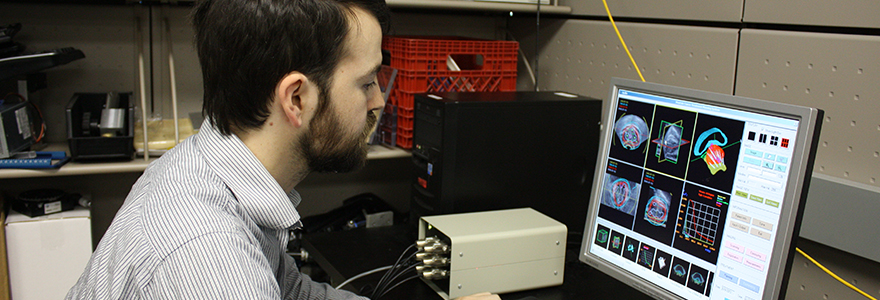Research
Recent Publications
Detective quantum efficiency of photon-counting x-ray detectors
Unified voxel- and tensor-based morphometry (UVTBM) using registration confidence
Medical Imaging Research

Our Imaging Research Partners
Robarts Research Institute
The Imaging Research Laboratories at Robarts focus on the discovery and development of innovative imaging techniques and instrumentation to improve the understanding, diagnosis and treatment of human diseases including cancer, cardiovascular and orthopedic disease, schizophrenia and other brain disorders. Using x-ray, ultrasound, CT and MRI, the group is the largest in the Institute, conducting research across nine broad themes:
- basic imaging science & engineering
- brain and mind imaging & spectroscopy
- cancer imaging
- cardiovascular imaging
- clinical Imaging Research Laboratories
- image-guided surgery & therapy
- molecular, cellular and micro-imaging
- musculoskeletal imaging
- respiratory imaging
Western researchers find that a new COPD therapy device makes breathing easier.
New imaging research shows increased iron in the brain in earliest stages of MS.
Lawson Health Research Institute
As a world leader using state-of-the-art imaging technology, our research is focused on the development of non-invasive capabilities and diagnostic imaging so that we can better understand the fundamental mechanisms of human biology and enhance the diagnosis, prevention and treatment of disease. Imaging facilities at Lawson include:
An overview of the Lawson Imaging Program as Dr. Frank Prato is awarded the 2014 Lawson Impact Scientist Career Award.
Dr. Ting-Yim Lee received the 2014 Lawson Impact Award for Innovation.
Some of our participating faculty members in this video, Drs. Frank Prato, Gediminas Cepinskas, and David Palma discuss their research.
Biomedical Imaging Research Centre (BIRC)
The Biomedical Imaging Research Centre (BIRC) is a multi-disciplinary, multi-institutional group comprised of over 350 personnel, including scientists, engineers, physicists, students, and support staff in London, Ontario, Canada. The imaging research groups are tightly integrated with the major hospitals in London, enabling the discovery and development of innovative imaging techniques and instrumentation to improve the understanding, diagnosis and treatment of human diseases. The group provides specialized training programs for graduate students through various departments of Western University and the Research Institutes listed below. The group as a whole has a research infrastructure valued at over $100 million.
Graduate studies at all the partner institutions of BIRC provide students with stimulating transdisciplinary environments to carry out their research, which may be experimental, theoretical, or computational.
Graduate Supervisors in the area of Imaging:
Dr. Rob Bartha (Robarts)
Dr. Corey Baron (Robarts)
Dr. Gordon Campbell (NRC)
Dr. Jeff Carson (LHRI)
Dr. Blaine Chronik (Robarts)
Dr. Ian Cunningham (Robarts)
Dr. Maria Drangova (Robarts)
Dr. Mamadou Diop
Dr. Savita Dhanvantari (LHRI)
Dr. Aaron Fenster (Robarts)
Dr. Paula Foster (Robarts)
Dr. Neil Gelman (LHRI)
Dr. Donna Goldhawk (LHRI)
Dr. Justin Hicks (LHRI)
Dr. Lisa Hoffman (LHRI)
Dr. David Holdsworth (Robarts)
Dr. Ali Khan (Robarts)
Dr. Michael Kovacs (LHRI)
Dr. Jim Lacefield (Robarts)
Dr. Ting-Yim Lee (Robarts/LHRI)
Dr. Grace Parraga (Robarts)
Dr. Terry Peters (Robarts)
Dr. Tamie Poepping (Hemodynamics, Cardiovascular Biomechanics)
Dr. Frank Prato (LHRI)
Dr. Andrew Pruszynski (Robarts)
Dr. Keith St. Lawrence (LHRI)
Dr. John Ronald (Robarts)
Dr. Timothy Scholl (Robarts)
Dr. Rob Stodilka (LHRI)
Dr. Jean Théberge (LHRI)
Dr. Jonathan Thiessen
Dr. Alex W. Thomas (LHRI)
Dr. R. Terry Thompson (LHRI)
Dr. Aaron Ward (LRCP)
Dr. Gerald Wisenberg (LHRI)
Our faculty and their graduate students conduct research in partnership with globally recognized faculty supervisors and clinicians at state-of-the-art facilities located at Western University, London Regional Cancer Program, Lawson Health Research Institute, Robarts Research Institute, and the London Health Sciences Centre. After graduation, students find rewarding careers in the healthcare sector, biomedical industry, and academia; others pursue further training in professional schools such as medicine, dentistry, or business.
If you have a 4 year Honours Degree (or MSc) in Physics, Chemistry, Engineering, Computer Science, Mathematics, Biology, Medical Sciences or a related field, and are interested in biomedical research, you are invited to apply to our graduate program.








